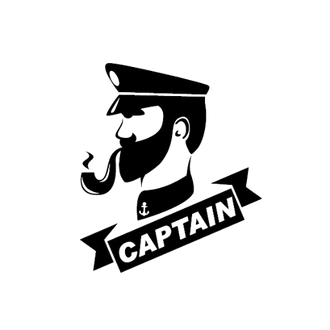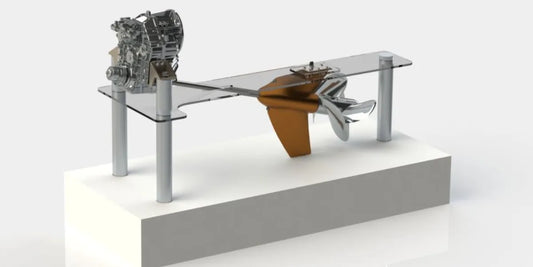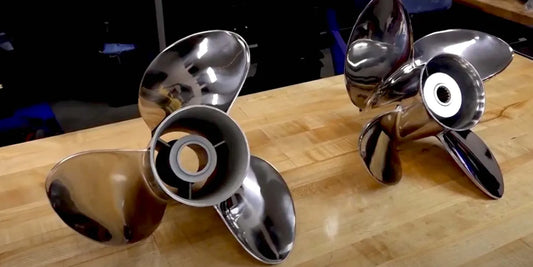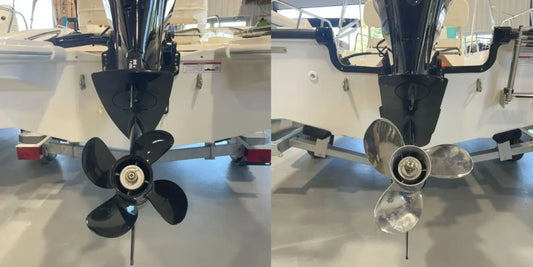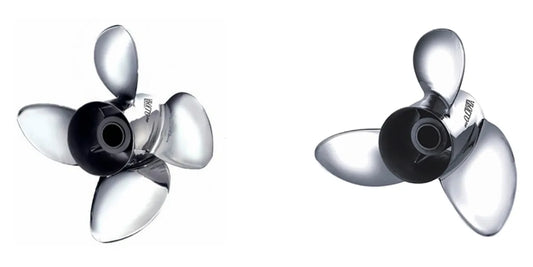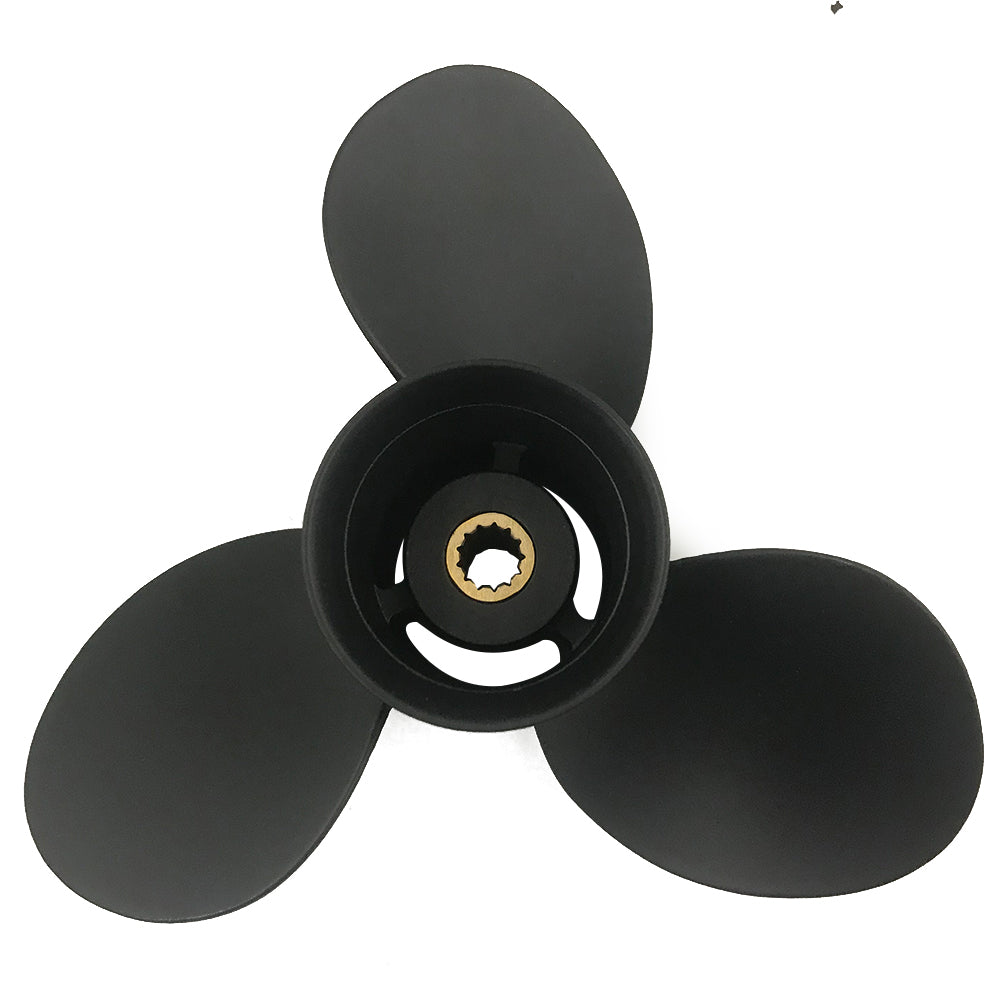Every piece of equipment of a boat adds value to its experience on water. Outboard propellers are fundamental instruments that influence speed, efficiency, and maneuverability. Yamaha outboard propellers are designed to assist boating activities, from leisurely cruises to competitive racing. This blog discusses propellers as the unsung heroes of the synergy between the boat and water. Yamaha's innovative designs, advanced technology, and superior craftsmanship are singlehandedly cutting-edge in ensuring peak performance in outboard motors. Whether you’re a regional expert or merely a few times a year enthusiast, knowing the best propeller will improve your marine experience.
What are the benefits of using Yamaha propellers for outboard motors?

How do Yamaha propellers improve fuel efficiency?
Yamaha propellers' advanced drag-and-thrust-centric design and engineering enhance fuel efficiency. To ensure power transfer is effectively delivered to the water, Yamaha employs high-precision tilted blades with diameter and pitch optimized for specific engine models. Furthermore, Yamaha’s incorporation of stainless steel and aluminum propellers reduces fuel-inefficient weight without losing propeller strength, increasing energy efficiency and yielding smoother operation.
Blade Geometry: Thanks to the advanced blade design, water flows through the blades with much less resistance.
Pitch Optimization: Strikes an effective balance between speed and thrust.
Diameter Adjustment: Enables effective engine power regulation to minimize drag and increase output.
Materials: Enables propellers engineered from lightweight and durable materials, enhancing performance and fuel efficiency.
These innovations guarantee impressive performance and efficiency by delivering better mileage, lower fuel consumption, and reduced operational costs.
What performance advantages do Yamaha props offer?
Performance Yamaha props have their respective advantages, which combine effective and reliable performance with safety.
Fuel Efficiency: When in motion, Yamaha props efficiently optimize the thrust while rapidly reducing drag. This cost-effective feature results in savings during fuel consumption.
Enhanced Acceleration: The precise adjustments in the pitch and diameter enable the prop’s throttle to increase acceleration in a reduced time frame, which is essential for high-performance applications.
Durability: Yamaha proposes innovative construction using strong but light materials that increase resistance to wear while promoting reliability.
More incredible Speed and Control: Advanced blade design and materials imply higher speed, aiding in swift handling and a smoother surface, increasing control and stability.
Reduced Engine Strain: By prolonging the pitch, diameter, and prop material, combustion engines experience less stress, extending their performance lifespan.
These technical parameters show that Yamaha focuses on providing cost efficiency while leveraging the benefits of high-performing propeller solutions.
Are Yamaha propellers compatible with different outboard brands?
Although several outboard motor brands utilize Yamaha propellers, compatibility varies with individual engine models and propeller features. Yamaha maintains this adaptability by incorporating various hub systems, including modular hub kits and SDS (Shift Dampener System), which enable easy installation on different outboards. Some of the major technical features that define compatibility are:
Propeller Hub Design: Modular Yamaha propellers are not brand-specific, and the outboard is guaranteed, which ensures proper and efficient fitting.
Pitch and Diameter: Effective operations are ensured for all brands when muscle alignment within pitch and diameter is in sync with the engine specifications.
Spline Configuration: Easy sailing is achieved when a propeller's spline count and size match a compatible outboard shaft.
With these technical details, Yamaha propellers flexibly adapt to many outboard engines while delivering exceptional performance. Always check the specific compatibility charts or contact a Yamaha expert for the correct fit to your model.
How do I choose the right Yamaha propeller for my boat?

What factors should I consider when selecting a Yamaha prop?
Choosing an optimal Yamaha propeller for your engine and boat requires considering a few distinct factors. Some of these factors are as follows:
WOT RPM Range: To ensure your outboard motor is working at its best, select a propeller that keeps the engine within the range for peak efficiency and optimum engine health.
Boat Size and Weight: The boat's size, weight, and load affect the propeller's ability to perform and plane; remember to consider these.
Propeller Pitch: A propeller with a lower pitch will generally provide much better acceleration and pulling forces than a propeller with a high pitch. On the other hand, high-pitch propellers also greatly enhance the boat's top speed.
Material: Yamaha propellers come in two varieties: stainless steel and aluminum. Aluminum propellers are light and cheap, whereas stainless steel propellers provide added durability and performance.
Number of Blades: Consider whether you want a 3 or 4-blade propeller since it makes a difference in performance. More blades mean better cavitation smoothness but may decrease performance speed slightly.
Spline Count and Diameter: Confirm that the propeller’s spline count and diameter match the shaft of the outboard engine.
All the parameters listed affect how your propeller fits your engine and boating activities. For expert advice on pairing your boat and engine, consult Yamaha’s compatibility charts or a professional.
How does blade count and pitch affect propeller performance?
Blade Count:
Thrust and Efficiency: Increasing the number of blades can improve thrust and reduce vibration, albeit at the cost of a slight efficiency drop due to increased drag.
Application: Propellers with three blades are widely used for generic purposes as they offer a good average speed and high efficiency; however, four-blade props are superior in acceleration and hold power in adverse weather conditions.
Pitch:
Speed and Power: The degree of propulsion or pitch drives the higher the number of engine revolutions the boat can complete, increasing the upper-speed limit. Consequently, the engine's power will need to be increased to reach optimal level, conversely, lesser pitch can enhance load speed maximum, while restricting top speed power.
Engine RPM: An optimal pitch limit will guarantee the engine remains at its desired RPM. Use higher or lower than this band and draw close to inefficiency or straining your engine.
Optimizing your propeller’s pitch and blade count to the vessel’s purpose, load, and engine specifications will yield ideal fuel efficiency and performance.
What's the difference between aluminum and stainless steel Yamaha propellers?
Properties and performance grade the difference between aluminum Yamaha propellers and stainless steel Yamaha propellers.
Durability: Damaging stainless steel propellers is not a debris issue, and the impact on steel remains far more robust. Harsh conditions cause aluminum propellers to bend and break with ease.
Weight: Aluminum propellers are better suited for lower-powered or smaller boats. Strength is added with steel, but the weight balance is slightly compromised.
Performance: Rigid stainless steel propellers have unrivaled performance, enhancing efficiency while providing a better boost in acceleration range. Flexing aluminum propellers in similar scenarios, while helpful in some cases, causes performance loss.
Cost: General recreational services with aluminum propellers can be enjoyed on a budget. However, frequent use of stainless steel propellers, which are more expensive, achieves long-term value.
Stainless steel Yamaha propellers are exceptional for high power and controlled use, while aluminum propellers stand out for their power requirements. Pick your desired specification, as a blend of budget and performance must be considered.
What are the top Yamaha propeller models for different boating activities?

Which Yamaha props are best for high-performance boats?
Saltwater Series II and V MAX SHO are excellent options for Yamaha propellers suited for high-performance boats.
Saltwater Series II: This propeller is built for larger offshore boats with remarkable acceleration and top-end speed. It has a highly polished stainless steel outline for durability and blade geometry that is conducive to high-speed use. It is also well-suited for use with V6 outboards, making it ideal for high-performance saltwater situations.
V MAX SHO is best tailored for bass boats and other high-speed uses. The propeller's holeshot and mid-range performance are exceptional, but most importantly, the V MAX SHO has a vent-less design, which increases speed and acceleration while reducing cavitation. It is made for high-rpm use and has a durable stainless steel finish.
Both have different specialized uses. The V MAX SHO is tailored for competitive and freshwater environments, while the Saltwater Series II excels in open water. Accomplishing maximum efficiency with these propellers will always require adequately matching the engine’s specifications and intended activity.
What are the ideal Yamaha propellers for pontoon boats?
Yamaha offers a selection of specially constructed propellers for pontoon boats designed to improve their overall performance and maneuverability. Two of the most common are the Yamaha Pontoon Performance Series and Yamaha Talon SRX Propellers.
Yamaha Pontoon Performance Series
Blade Design: Increased area of blades to enhance thrust and lifting effeciency at low speed with heavy payloads commonly found on pontoon boats.
Material: Constructed of aluminum, offering a balance of strength and affordability.
Pitch Options: From 9" to 16", accommodating various engine-power combinations and boating activities.
Yamaha Talon SRX
Blade Design: Deep rake, more extensive primary with progressive pitch, offering better acceleration and fuel efficiency.
Material: Made from stainless steel, offering excellent durability and resistance to rust.
Optimal Usage: Excellent for pontoon boats cruising over unknown waters, robust yet durable.
Both alternative propellers recognize the distinct propulsion needs of pontoon boats, emphasizing effortless control, fuel economy, and power thrust with heavy loads. Yamaha-powered pontoon boats will get the best results when the propeller's pitch and diameter are precisely fitted to the specific engine and intended use.
Which Yamaha propeller models excel in shallow water conditions?
In shallow waters, propellers in the Reliance Series and Talon SS4 of Yamaha are best suited for Yamaha engines. I would lean towards the Talon SS4 for these challenges as its design helps mitigate ventilation and provides grip in more challenging environments. The four-blade propeller is optimal for lift and bite, two necessary things when dealing with shallow waters. The other side of the coin resides with the Reliance Series, which is known to have good handling and fuel efficiency and is suitable for deeper waters.
Pitch and diameter are critical technical features to focus on. As previously mentioned, a propeller with a large diameter and moderate pitch improves throttle response even in shallow waters. The same principles apply here. The Talon SS4 propeller tournaments with a 17” and 19 "pitch work great in these circumstances. Finally, ensure your Yamaha engine model is compatible to guarantee performance and longevity.
How do I properly maintain and care for my Yamaha outboard propeller?

What are the recommended cleaning techniques for Yamaha props?
To begin, my Yamaha propeller receives a thorough rinse after every outing. This is particularly important following operations within saltwater domains, as salt, coupled with other debris, possesses the capability of corroding the propeller over time. To further refine the cleaning process, I apply a generous amount of mild detergent to scrub off any substantial grease marks while using a soft brush to ensure no further damage is done to the surface of the propeller. I also check meticulously for any fishing line or other debris found around the propeller shaft, as even the most minor bits can cause irreversible damage to seals and significantly impact performance.
Neglecting observable maintenance will lead to added fuel consumption, more drag, and a negative overall effect on performance. In addition to the corroded shaft, the pitch and blade alignment suffer due to the excessive corrosion, significantly decreasing acceleration and speed. My clean propeller allows my Yamaha to perform optimally while sustaining its longevity.
How often should I inspect my Yamaha propeller for damage?
Marching towards every outing, it is recommended that you inspect your Yamaha propeller for any signs of damage. Visual checks are worth performing regularly if you want to track issues earlier, such as nicks, bends, or corrosion. For the most accurate inspection, I recommend checking the propeller thoroughly once a month or after using it for twenty to thirty hours, depending on how frequently you utilize it. Here are some key parameters that need to be cross-checked:-
Blade Condition: Check for dents, cracks, or warping that can interfere with the propeller's balance and performance.
Propeller Shaft: Look for fishing lines or debris that can obstruct and damage the seals, leading to leakage.
Corrosion: Determine whether or not there is surface pitting or colorization, particularly in saltwater environments, alongside checking especially profoundly, or else further degradation will ensue.
Check pitch and alignment: Verify whether the propeller maintains the desired pitch and blade alignment necessary to maximize speed and acceleration.
Tracking this regularly will fend off expensive repairs and increase fuel efficiency while reducing the strain on the engine.
What signs indicate it's time to replace my Yamaha outboard propeller?
Signs that show it may be time to replace your Yamaha outboard propeller are:
Vibrations: If you consistently feel weird movement patterns while running the outboard, it may be due to an unbalanced or damaged propeller shaft.
Performance: Any drastic drop in acceleration, speed, or fuel usage over a considerable period often means the propeller is damaged or worn out.
Blades: A set of blades that are cracked, chipped, bent, or have any form of dents that will compromise performance and ensure that the engine undergoes inevitable stress.
Engine: Having the wrong pitch on a propeller (or a damaged one) can result in the engine running at higher RPM, severely increasing strain and decreasing lifespan.
Cavitation: If excessive cavitation or poor water flow track maintenance is an issue, the propeller needs further investigation.
A proactive approach can minimize and prevent mechanical breakdown while maximizing performance.
Can I upgrade my current outboard propeller to a Yamaha model?

How do I fit a Yamaha propeller into my outboard motor?
Examine Compatibility: Make sure the Yamaha propeller matches your outboard motor before anything else. Check the shaft size, propeller diameter, spline count, and pitch. These details affect the performance parameters of speed, thrust, and fuel economy; hence, they must be compatible with the motor’s specifications.
Take Off the Previous Propeller: Begin by locking the motor in place. Use a wrench to take off the propeller nut. Once taken off, gently slide the old propeller off the shaft while inspecting the thrust washer for damage.
Examine the Propeller Shaft: Wash the shaft and look for any wear, corrosion, or dirt. Keeping the shaft clean and well-maintained guarantees straightforward installation and superb performance.
Put the Yamaha Propeller On: Insert the thrust washer onto the shaft and fit the new Yamaha propeller in position while matching it to the splines. Try to fit the propeller snugly, but do not forcefully insert it. The propeller nut needs to be put back and tightened to the appropriate torque following the manufacturer’s instructions so it does not malfunction during use.
Regulate and Assess: Use the propeller post-installation to check its alignment and performance. Look out for unusual vibrations and accelerations that are poor or over-revving, as these are all signs that the propeller’s pitch and fit need to be evaluated for better engine health.
When you check things like the diameter, pitch, and spline, it is easier to switch to a Yamaha propeller and enjoy its benefits on your outboard motor.
Do Yamaha propellers require special hardware for installation?
Yamaha propellers come with specific peripheral hardware like a thrust washer, spacer, propeller nut, and a cotter pin or lock that will differ from model to model. These parts are essential for properly attaching and stabilizing the propeller on the shaft so that the equipment can function optimally. While choosing or changing a Yamaha propeller, it is equally important to check compatibility with the following principal parameters:
Diameter and Pitch: The propeller's diameter must cater to the requirements of the engine and its functioning.
Shaft Spline Count: The propeller must suit the spline arrangement of the outboard's shaft.
Torque Specifications: Over-tightening the propeller nut can cause slippage and damage to the unit, which should be avoided.
Employing the correct propeller peripheral hardware and observing precise installation and technical specifications will guarantee proper setup and performance for the Yamaha propeller, ensuring optimal performance and dependable service life.
Which Yamaha propellers are compatible with in-line four-cylinder outboards?
In aligning with the Yamaha propeller compatibility list for an outboard in-line four-cylinder engine, I check if its specific technical parameters are met. For these motors, Yamaha suggests where they can be obtained, including Reliance Series propellers, Saltwater Series II, and Yamaha Talon series, as per application requirements. The following are some of the principal parameters that I take into account:
Diameter and Pitch: These propellers are manufactured within a range; therefore, I choose those with the desired diameter and pitch for the particular engine output and performance.
Shaft Spline Count: Almost all in-line four-cylinder Yamahas come with a 15-tooth spline, I now ensure that the meassured propeller has such features.
Material and Design: These relatively larger-diameter stainless steel propellers are superior in durability and efficiency, particularly in salty waters.
Propeller Nut Torque: Following the recommended torque from Yamaha prevents problems such as slippage while ensuring secure fitment.
Selecting a propeller that meets these parameters gives assurance and satisfaction of efficiency and compatibility with any Yamaha in-line four-cylinder outboard.
Frequently Asked Questions (FAQs)
Q: What are the main differences between aluminum and stainless steel propellers for Yamaha boats?
A: The performance of stainless steel propellers is far better than aluminum. Stainless steel also tolerates flexing at high power loads, which helps with the efficiency of outboards. While aluminum propellers are generally more cost-effective and adequate for recreational boating, they do not compare to the performance of stopper steel propellers, especially in the context of high-performance activities or powering Yamaha outboard motors.
Q: How do I choose a Yamaha boat propeller that is suitable for me?
A: When buying a propeller, know your boat type, engine type, and what you plan on doing with it. If you own a Yamaha F200 outboard motor, check the Yamaha propellers catalog that matches that specific engine. Remember the number of blades (two blades vs three blades), pitch, and the diameter. Also, check out Yamaha’s economical precision propellers, such as the Turbo and Reliance series for high-performance applications. Always check with your Yamaha dealer or the manufacturer guide to guarantee correct assembly and vessel performance.
Q: How does a 4-blade propeller benefit a Yamaha outboard engine?
A: For Yamaha, a four-blade propeller translates to better all-around performance, particularly in improved acceleration, smoother turns, and reduced ventilation. This is important for achieving enhanced low-speed thrust, such as when positioning the boat over bait. In addition to these overall performance benefits, four-blade props can provide lower fuel consumption and smoother rides at cruising speeds compared to three-blade props, resulting in greater fuel efficiency.
Q: What are the advantages of Yamahas SDS Design when attached to boat props?
A: Unlike other features, Yamaha's SDS design doesn't need additional hardware, making it easier to implement. It also reduces shift clunk and prop rattle, allowing snappier shifting and quieter sound when changing gears. This design incorporation lessens the overall wear on the drivetrain components and improves the overall experience of boating. SDS is integrated into many precision propeller models of Yamaha and is compatible with virtually all Yamaha outboard motors.
Q: What is the Turbo 1 Stainless Steel Propeller, and What Are Its Benefits?
A: Turbo 1 stainless-steel propeller is made for outboard motor systems with twin engines. With it, you will have phenomenal thrust in acceleration and maximum speed. It is an oh-so-good prop for lightweight, high-speed applications. This prop works best for T50-F115, which is used by flatboats and many other class vessels that need fast acceleration and economical cruising. This prop provides further enhanced performance for the latter application.
Q: How do Yamaha Propellers Complete the Performance Package of V MAX SHO Engines?
A: Yamaha-designed propellers for the V MAX SHO (Super High Output) Continuous Engines are custom-made for these very powerful outboard engines. Yamaha V MAX SHO propellers feature stainless steel precision parts and propulsion systems that better use the engine's power gained during V MAX SHO. Instead of dragging behind, these props improve thrust, maximum operating speed, and performance, allowing V MAX SHO operators to utilize the whole potential of the Yamaha outboard motor in many boating types.
Q: Do Yamaha's OEM boat props outperform aftermarket ones?
A: Generally, most people consider OEM boat props from Yamaha better than other aftermarket parts. The main reason is that OEM props are made and tested for Yamaha outboard motors. These propellers are designed to meet Yamaha's rigid performance and quality requirements, ensuring exceptional fit and functionality. While some aftermarket props are high-quality, reputable, and perform well, nothing compares to the performance of Yamaha Marine OEM propellers since they guarantee peace of mind in terms of warranty with the Yamaha outboard engine.
